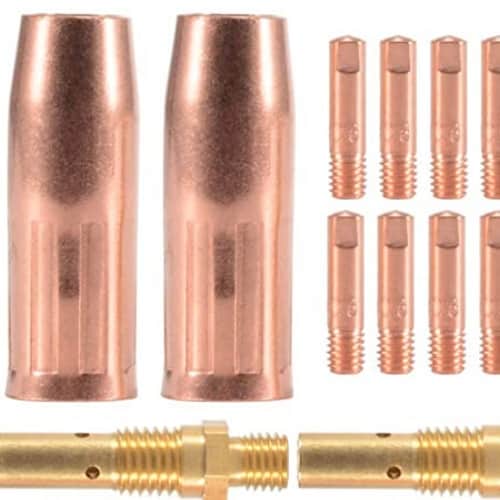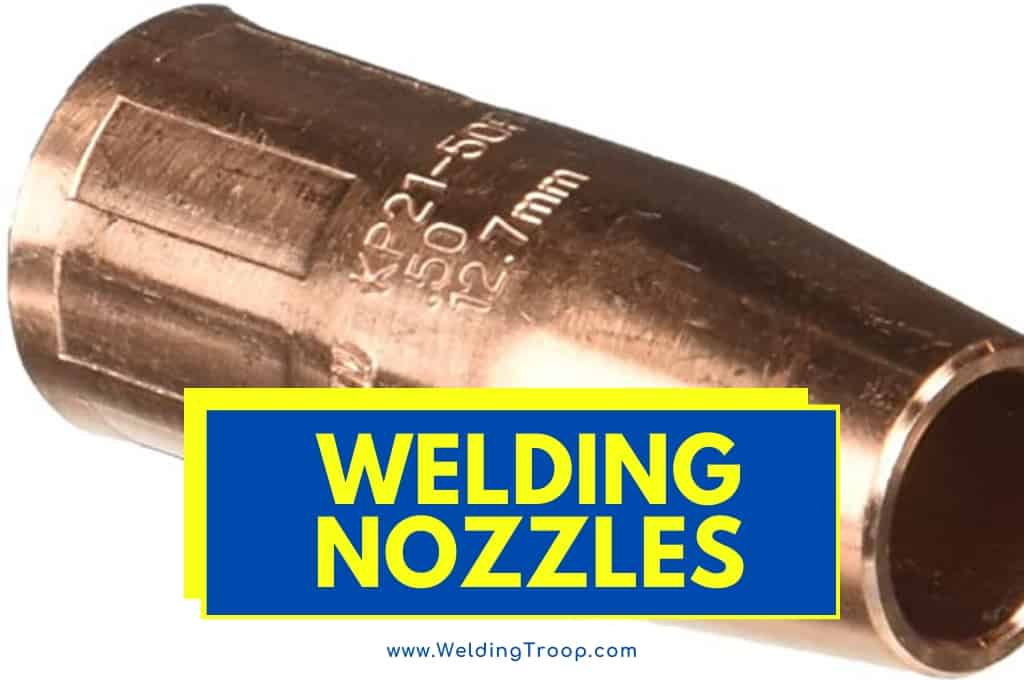Manufacturers design different welding nozzles for separate tasks, but do you know what are the metal welding nozzles are made of? The nozzle’s material signifies which types of welding it’s best suited.
What are welding nozzles made of? Welding nozzles are made of brass, copper, nickel-plate, and ceramic materials. Depending on the kind of welding, each nozzle has its advantages and disadvantages.
Arc welding, like other forms in the industry, is in high demand. Because an increasing number of skilled welders are retiring, and global markets continue to expand, the welding industry is in the midst of a labor shortage. Choosing the right nozzle for the job is a crucial step to becoming an experienced welder.
Each type of nozzle has a different tolerance for heat and has unique characteristics that make it ideal for specific tasks. Efficiently welding while you’re on the clock is a top priority, and if you choose the correct type and style of nozzle, your job will be a lot easier and safer.
Table of Contents
What Types of Jobs Should You Use Each Nozzle For?
Metal Inert Gas (MIG) welding is a form of arc welding. An electrode wire feeds into a welding gun and into the weld puddle. The gun’s nozzle directs the inert gas onto the puddle and protects the weld from oxygen and nitrogen contamination.
Each nozzle, whether brass, copper, nickel-plate, or ceramic, has a different use and effect while welding. Let’s go through each one and what they are used for.
Brass Nozzles
One of the most common materials for welding nozzles is brass. Brass is less durable than copper, and high-end brass nozzles are more durable than inexpensive ones. When selecting a brass model, only purchase mid to high-end nozzles.
The cheaper nozzles are not durable or reliable, like the more expensive ones. Avoid nozzles that have nicks or cuts in the surface. More affordable models with blemishes will attract more spatter and will not last long. The following list displays the characteristics of brass nozzles and which jobs they’re suited for.
- At low amperage, it has superior spatter resistance
- Low amperage jobs
- Short-term tasks
- Semi-automatic welding
Ability to Resist Spatter
The tiny drops of filler metal that can clog up your nozzle are called spatter. If you fail to clean the spatter from nozzles frequently, you’ll produce distorted welds and will have to replace the faulty nozzle. Brass models resist spattering more efficiently at lower amperages than copper or nickel-plated ones.
Lower Amperage Jobs
Due to its lower melting point, brass is a better material for welding at lower amperage and temperatures. Brass nozzles are suited for amperage between 100 and 300. If you use a brass nozzle at amperage above 450, the nozzle can melt and possibly shatter.
Short-Term Tasks
Because it’s not as durable as other nozzle materials, brass nozzles are ideal for shorter applications. Projects that take several hours or days are more suited for copper or nickel-plated nozzles.
Semi-Automatic Welding
Typically, brass nozzles are only used in a semi-automatic situation with a human operator.
Automatic welding involves a fully automated welding machine that uses a robot operator to guide the welds. Most automated robots, like the ones used by automobile manufacturers, use copper or nickel-plated nozzles rather than brass ones.
Assembly line applications involve several hours of constant welding, and brass is not durable enough to withstand the harsh demands of automatic welding.
Copper Nozzles
Like brass, copper is another common material for welding nozzles. However, copper’s properties are vastly different from those of brass. The following list shows copper’s characteristics and which jobs it’s designed for.
- Highly Durable
- High resistance to spatter at mid-level amperages
- More effective at absorbing heat
- Semi-automatic or automatic tasks

High Durability
Copper nozzles are more durable than copper ones and are suitable for short-term and long-term applications. Due to its high melting point, copper withstands higher amperages and temperatures.
Resistance to Spatter
At higher amperages, copper is superior to brass at resisting spatter. If you use copper nozzles for high parameter applications, the nozzle will not quickly clog up with spatter like a copper nozzle under the same conditions.
Heat Absorption
An example of copper’s high durability is the metal’s ability to absorb heat effectively. A copper nozzle will not fail at an amperage of 450 like a brass nozzle, and its heat absorption properties enable it to withstand lengthy projects.
Both Auto and Semi-Auto
Unlike brass nozzles, copper nozzles are suitable for long projects that involve several hours of continuous welding. They are durable enough for robot operators to use them on an assembly line operation.
Nickel-Plated Nozzles
Nickel-plated nozzles are useful for welding with substantially high amperages. The nozzle has a copper core that is coated in nickel to insulate the metal and keep it cool.
It shares many of the same characteristics as copper, but nickel-plated nozzles last longer and can withstand higher amperages.
Although many welding operations use copper for high amperage tasks, nickel-plated nozzles are becoming a more effective alternative. Automatic welding machines that once used copper nozzles are often replaced with nickel-plated ones.
Nickel-plated nozzles are more expensive than copper ones, but they create less downtime in a workday because the nozzles are more durable and don’t require operators to replace them as often.
Ceramic Nozzles
A newer addition to the welding nozzle market is the ceramic nozzle. In MIG welding, ceramic nozzles are made of silver nitride. Although they have not been thoroughly tested like copper, brass, and nickel-plated nozzles, ceramic nozzles are more durable for high-amperage projects.
Ceramic nozzles are designed for long-term use at extremely high temperatures, and the nozzles are becoming more accepted by welding operators.
Their resistance to chipping helps the nozzles resist spatter at amperages over 500. Several operators replaced their nickel-plated nozzles with ceramic ones for automatic machines. When the nozzles become more cost-effective, they may soon become the nozzle of choice for welders.
Which Style Of Nozzle Should You Use?
When choosing nozzles, you have two style options.
Threaded Nozzles
You attach threaded nozzles by screwing them onto the welding gun. The connection is more secure than slip-on styles, and it keeps your consumable metals concentric.
Threaded nozzles are suited for long-term projects that don’t require frequent nozzle replacement. Most automatic welding operations use threaded nozzles.
One drawback to the threaded nozzle is its difficulty in replacing. Spatter can land on the nozzle’s threads, which causes the nozzle to stick to the gun.
Experts recommend using larger threaded nozzles rather than using the finer threads. Larger threads are less likely to become clogged with spatter and are easier to remove.
Slip-On Nozzles
Slip-on nozzles are ideal for short-term projects, and they’re frequently used for overhead tasks such as welding a car’s undercarriage. Due to their slip-on design, the nozzles are quick and easy to replace.
However, they don’t provide a secure connection like threaded nozzles, and if you fail to attach the nozzle correctly, your consumables may sit off-center. If the electrode and tip are not centered correctly, you cannot adequately produce a sturdy weld.
Another problem with slip-on designs is their tendency to fall off the welding gun. After frequently removing the nozzle, the O-ring sometimes wears out and causes the nozzle to become detached.
Conical Nozzles
Nickel-plated nozzles often come in this shape. They do a good job of securing your welder against gas leakage while offering a wider opening, which can help you control your welding stream. That said, these tend to be less accessible than many of the other options on this list.
Flush Nozzles
A highly consistent and durable nozzle type, these are popular welding choices, though they aren’t as splatter-resistant as other nozzles.
Bottleform Nozzles
These nozzles are highly accessible, and can weld very cleanly, but with a tighter opening are also more prone to trouble if the atmosphere of the welding area changes.
Cylindrical Nozzles
These nozzles are sometimes simply called straight nozzles, which should give you an indication as to their size. They are used most frequently at high amperages, but can allow too much gas into your welding puddle if you aren’t careful. They are also less accessible than other nozzles on this list.
How Do You Maintain A Clean Welding Nozzle?
Keeping your nozzles clean and free of spatter is crucial if you want to ensure the nozzle’s longevity. Any dried spatter that remains after a weld should be removed with a wire brush.
Another way to reduce spatter buildup is to apply an anti-spatter spray or gel to the nozzle and base metals.
Before welding, you can dip the welding nozzle into the anti-spatter coating to protect against spatter buildup. You can also apply the coating or spray to your base metal before you weld.
When spatter meets the coating, it does not stick. You can merely wipe off the remaining spatter and continue welding.
If you’d like to watch a video of a welder explaining the merits of using a coating to reduce spatter, click here.
Closing Remarks
With all the styles and new options available in the nozzle market, you may feel overwhelmed when choosing the ideal nozzle.
However, brass and copper nozzles have proven to be useful for most tasks, and if you’re willing to spend a few more bucks on a nickel-plated or ceramic nozzle, you’ll likely appreciate the results. So, grab your welding gun, select a new nozzle, and get to work.
More Welding Articles
Easiest Way to learn Welding and How Long Does It Take?

